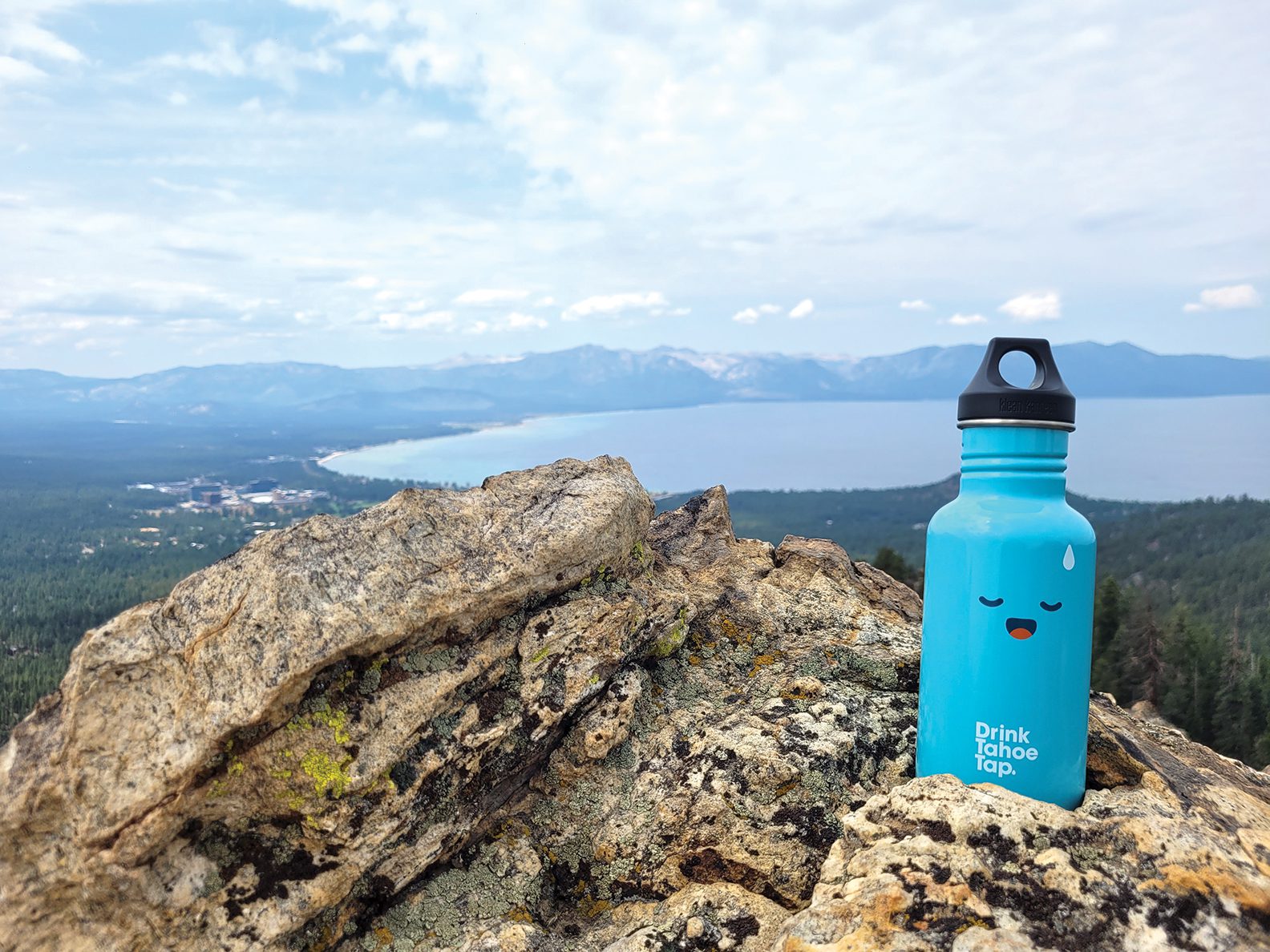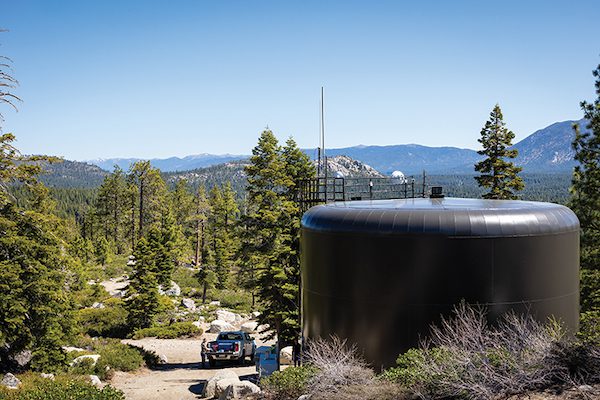
01 Jul Quality You Can Taste
A deep dive into why Lake Tahoe produces some of the best drinking water on earth
Lake Tahoe—as we have hopefully learned by now—is pristine. What circulates beneath its sapphire surface is some of the highest-quality water on the planet. And for those who call this place home, that includes the water we drink.
Of the approximately 160,000 public water systems in the United States, only 60 that use surface water (i.e., a lake or reservoir) are pure enough to earn a “filtration avoidance” permit, and six are in the Tahoe Basin. All are members of the Tahoe Water Suppliers Association (TWSA), which proudly touts its product through its Drink Tahoe Tap initiative.
“With 99.994 percent purity, Tahoe tap water has been voted the best tasting water in the country by the National Rural Water Association,” according to the TWSA, which encourages residents and visitors to ditch bottled water in exchange for refillable containers.
While many Tahoe communities source their drinking water directly from the lake, a significant portion of Basin residents drink groundwater, which also is heralded as having impeccable quality.
“We think we have the best-tasting tap water in the country,” says Dan Arce, lab manager with the South Tahoe Public Utility District (STPUD), which provides groundwater to residents from 11 active wells. “At community events, we often host a water taste test with our water, sourced from groundwater, another water district’s water sourced from Lake Tahoe, and bottled water. Whether it’s from the lake or groundwater, Tahoe’s tap water always wins.”
Filtered by Nature
Tahoe’s drinking water does not receive its exemplary marks by chance.
Forests, meadows and wetlands in the Tahoe Basin combine to filter each of the lake’s 63 tributaries before they terminate in Big Blue. The more these streams twist and meander, the more filtering takes place, as wandering waterways decrease the velocity of water through friction and force debris and pollution to be adsorbed.
This process helps maintain Lake Tahoe’s famed clarity and explains its exceptional drinking water—whether pumped from the lake or drawn from the ground before reaching people’s homes.
Groundwater is considered the créme de la créme for drinking. It is deep below the surface (STPUD’s wells average 200 feet deep), traveling for months or years through sand, bedrock, clay, loam and more. As a result, bacterial loads are typically lower than those from surface water systems.
Unlike human-engineered filters that mimic nature’s process, this method of filtration will function indefinitely—provided we respect its botanical and hydrogeological mechanisms and minimize pollution. Land conservation and water quality go hand in hand.
‘No Such Thing as Zero’
Chlorine is part of the Tahoe tap water experience, but not for reasons you might expect. California regulations require public water suppliers to maintain a base level of chlorine to ensure no bacterial outbreaks harm consumers.
When homes are vacant, the water supply sits in the building’s pipes awaiting delivery. Arce suggests flushing pipes for several minutes if you’ve been absent from your home. While wasteful, doing so will eliminate the tastes, odors and discoloration associated with stagnant water.

The South Tahoe Public Utility District’s water tank. The utility provides drinking water to residents from 11 active wells, photo courtesy STPUD
“Vacant homes make the job of water suppliers challenging, requiring more maintenance than populated neighborhoods that draw upon their water regularly,” says Arce.
Tahoe’s tap water suppliers maintain a hydrant flushing schedule to ensure the water in the distribution system always remains fresh and potable.
An interesting note: Aside from chlorine’s bad taste, the chemical is hard on houseplants. But there’s a solution. The agent is volatile, meaning when you agitate a glass of water with a spoon or set a pitcher of water on the counter, the chlorine dissipates within roughly a half hour. A common water filter such as a Brita can remove traces of minerals and chlorine as well, but it’s critical to change filters before they build up bacterial scum.
While most public suppliers provide potable water, nobody drinks 100 percent water. It would taste terrible. There’s more to water than hydrogen and oxygen. Like wine, water exhibits a natural occurrence known as terroir, with its regional characteristics reflecting environmental factors like soil, climate and topography. Mineral content determines its taste—and, in some cases, affects its safety.
Humans are exposed to innumerable hazards, both man-made and natural. Elements like lead are harmful at any level. Other hazards require exposure at a high concentration for an extended period before harm is induced. In other words, there are safe levels of exposure to harmful agents. Uranium is one of them.
Granite contains veins of uranium. The Tahoe region has an abundance of granite from the cliffs of Donner Summit to the manzanita-studded slide paths along Emerald Bay. We experience radiation whenever we expose ourselves to the sun or the plentiful granite dust on our trails.
The uranium in Tahoe tap water is not necessarily harmful though. This is the crux behind the concept of purity; we assume potable water is void of everything. But nature isn’t that simple. STPUD and other utilities around the lake have low quantities of radon in their groundwater due to the naturally occurring granite in the region.
“There’s no such thing as zero in drinking water,” says Arce. “It’s all about detection limits and concentrations.”
That is to say, there will always be imperfections, even in the purest sources of water. It’s a matter of evaluating which risks are acceptable and what reasonable actions should be taken.
The Dark Side of Bottled Water
In its annual litter cleanups, the League to Save Lake Tahoe has removed nearly 98,000 pounds of trash since 2014, including 20,500 plastic bottles and 31,900 plastic bottle caps.
“A decade of leading litter cleanups and gathering data on the trash we find has shown us the main sources of litter in Tahoe, and single-use plastic water bottles are near the top,” says Laura Patten, natural resource director with the South Shore-based nonprofit. “The real value of this data is that it leads to solutions, like restricting access to common sources of litter, which we’ve been able to do with plastic bags, Styrofoam and single-use plastic water bottles.”
With this knowledge, South Lake Tahoe banned the sale of single-use water bottles on Earth Day 2024. Truckee will follow suit in spring 2025.
Why do people buy water—at high prices, no less—when they could instead drink tap water? The motivation is often rooted in misconceptions.
Public utilities charge about a penny per gallon. Meanwhile, privately bottled water companies charge about $9 per gallon. That’s because consumers pay for ships and trucks to transport the water, employees to stock it on shelves, marketing intended to make people feel good and the manufacturing of the plastic bottles. It’s not cheap to ship Perrier from France to California.
After setting aside ample room for profit, companies are not inclined to cut into their margins by spending on monitoring for contaminants. Public utility budgets, on the other hand, are primarily spent on purification, laboratory operations and maintenance of a reusable distribution system.
The gap in safety standards can be attributed to the different regulatory agencies that manage each sector. Bottled water companies are primarily regulated by the FDA, despite the fact water is neither food nor drug, while tap water providers are heavily regulated by the EPA. Bottled water companies mirror some requirements set by the EPA, but the mandates are not consistent with tap water—nor are they as proactive.
Many simply assume bottled water is safer because we rarely, if ever, see bad press. But bottled water companies have a hushed history of selling contaminated products. As noted by scientist and freshwater expert Peter Gleick in his 2010 book Bottled and Sold: The Story Behind Our Obsession with Bottled Water, while public water systems are required to promptly report any quality issues, the FDA does not “require careful monitoring, reporting or recalls of contaminated bottled water.”
As a result, bottled water has been “found to contain mold, sodium hydroxide, kerosene, styrene, algae, yeast, tetrahydrofuran, sand, fecal coliforms … glass particles, sanitizer … and crickets.”
Tap water may not be perfect, but at least it’s transparent.
Emerging Concerns
The EPA’s innovative approach, known as the UCMR (unregulated contaminant monitoring rule), investigates new chemical threats to the tap water supply. Industrial and agricultural manufacturers are permitted to produce chemical agents until the EPA can prove there are unacceptable human or environmental health effects.
Enforceability is costly, difficult and time-consuming, but the process works. PFAS, a relatively new but widely used chemical group—also known as “forever chemicals” because they never break down—illustrates how UCMR functions.
Public water agencies are required to test for 29 types of PFAS (there are thousands). The manmade compound is prevalent in household materials, including Teflon cookware, as well as stain- and water-resistant textiles like Gore-Tex. As society uses PFAS, it accumulates in our bodies and the environment, contaminating our soil and water supply.
The EPA set the first limits on PFAS in tap water in April 2024. The recommended exposure limit to certain types of forever chemicals is zero. As such, some states have already responded with policies that limit the sale and manufacture of non-essential products containing PFAS.
The response reflects the urgency of the situation. It also places the burden where it belongs: on consumer products that indiscriminately poison people.
By limiting the tidal wave of toxic non-essential products, utilities no longer bear this burden alone. Water providers are still on the hook to clean up a mess they did not make, but at least the persistent flood of PFAS into the water supply will be curtailed.
As for Tahoe’s drinking water, “We didn’t find any PFAS in any of our wells in 2014, but that was at a higher detection limit,” says Arce, meaning the sensitivity of the tests was lower then. “Ten years later, the tests can now detect PFAS in parts per trillion instead of parts per billion. The EPA just came out with some PFAS limits; the district found one of these once in one well.”
Regarding the new PFAS regulations, Tony Laliotis, director of utilities at the Tahoe City Public Utility District, says water providers across the lake “are evaluating long-term monitoring options, which will determine the level of concern and direct what treatments are appropriate for each community.”
The Beauty of Transparency
Those who’d like to learn more about their community’s water quality can easily do so. The federal government requires public water suppliers to publish annual consumer confidence reports showing what the lab monitors and what was done to mitigate any issues.
You don’t need to be a scientist to comprehend the reports, which are written with consumers in mind. If your doctor says to limit exposure to certain chemicals or compounds that exist in your drinking water, you can review the report to determine if your water exceeds those requirements. The compound does not need to be outlawed for it to be measured.
This is the beauty of having a transparent public water system. Unlike bottled water, data is gathered and shared with the public so we can make informed decisions.
Here in Tahoe, that opportunity comes with the peace of mind of knowing that we have access to some of the best drinking water on the planet—straight out of the tap.
Meyers resident Frances Buerkens is a water-quality expert who has explored nearly every nook and cranny of South Lake Tahoe’s backcountry with her husband and feisty cattle dog. Her previous work in agricultural enterprises and the tap water industry inform her perspective on land and water conservation.




No Comments